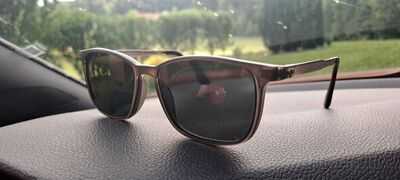
Motorists have been urged to keep sunglasses in their car after the clocks change on Sunday morning. Experts at AA Accident Assist stressed that road users could be at risk of suffering from major visibility worries this Autumn.
Low-lying sun and its reflection off wet roads can create a nightmare for drivers who could become frazzled behind the wheel. Since 2022, the AA claims there has been an 11% increase in crashes during the evening rush hour in the three weeks after the autumn clock change, compared to the three weeks before. Drivers have been warned to be more cautious on the roads between 4pm and 7pm to avoid being caught out and put at risk, with sunglasses likely to be a major safety feature.

Tim Rankin, managing director for AA Accident Assist, said: "Darker evenings seem to be catching some drivers out after the clocks go back, which has led to more collisions on the roads. Many of these crashes could have been avoided by simply keeping up with vehicle checks or by adjusting to autumn driving.
"Arguably, the best change would be to double the gap advice in the Highway Code, and leave a four-second gap between your car and the vehicle in front.
"Most incidents involve a car running into the back of another, so allowing more time to stop could be the difference between a near-miss and an expensive claim.
"During the day, low-lying sun can blind drivers, especially after a downpour where the glare bounces off the wet road. Keeping a pair of sunglasses close by can help drivers see the road ahead."
A Tesco Insurance poll of 3,006 drivers conducted between October 3 and October 7, 2025, found that 81% of drivers dislike driving in the dark.
A further 49% admitted their primary concern was bright headlights , while 27% accepted they generally struggled to see as well after hours.
Speaking exclusively to Express.co.uk, Dave Thompson, claims director at Tesco Insurance said: "The change in light levels is an annual shock to the system for many drivers. We are moving from months of daylight commutes to suddenly driving home in pitch darkness, all while battling the glare of oncoming headlights and increasingly inclement weather.
"The lack of familiarity with night-time driving, combined with the stress of the evening rush can result in more collisions than we'd normally see at that time of the day throughout the rest of the year."
You may also like

NFR accelerating railway developments in Bodoland region of Assam

Yadavs, Muslims & Bhumihars: How parties are solving Bihar's caste equations - candidate lists decoded

Furlenco Turns Profitable In FY25, Revenue Zooms 64% To INR 229 Cr

Madhya Pradesh: CM Mohan Yadav orders action against officials for negligence

Richard Ratcliffe draws parallels between his wife's detention and UK prisoners' plight






